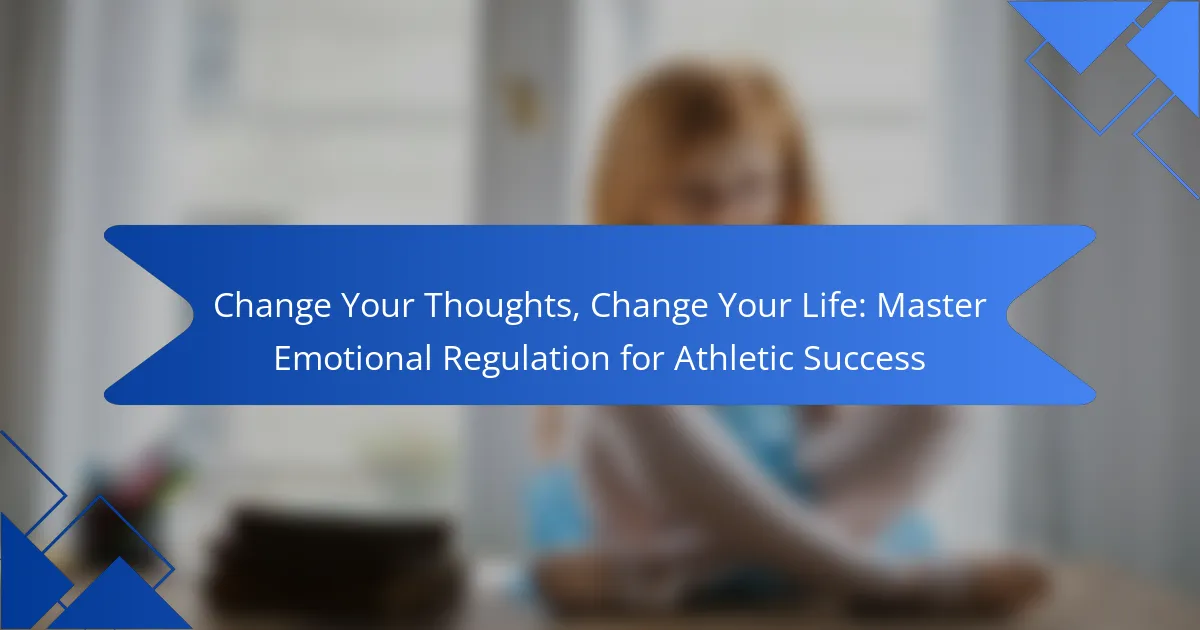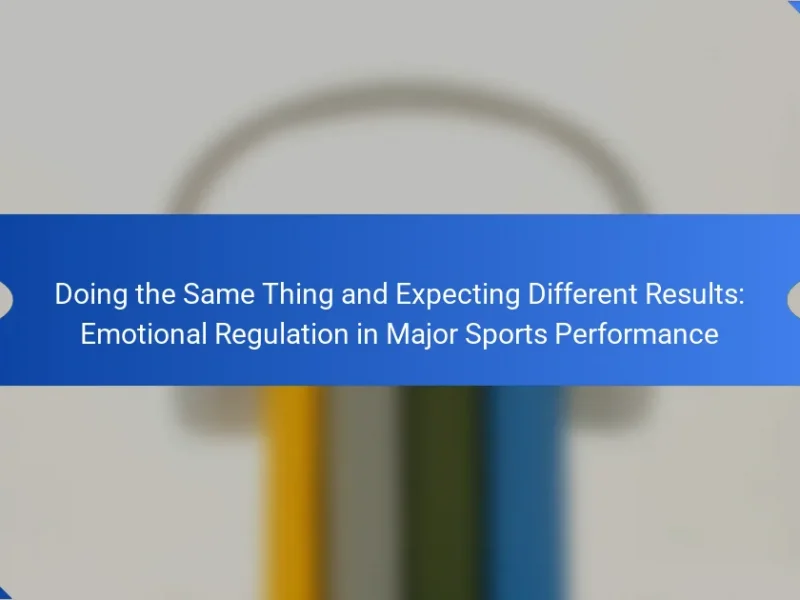Mastering emotional regulation is crucial for athletes seeking to enhance their performance and resilience. This article explores the benefits of emotional regulation, effective strategies like cognitive restructuring and mindfulness, emerging techniques such as biofeedback, and challenges athletes face, including performance anxiety and negative self-talk. By implementing these approaches, athletes can improve focus, reduce anxiety, and achieve greater success in competitive environments.

How Does Emotional Regulation Impact Athletic Performance?
Emotional regulation significantly enhances athletic performance by improving focus and resilience. Athletes who master their emotions can maintain composure under pressure, leading to better decision-making and execution. Studies show that emotional intelligence correlates with improved performance metrics, such as reaction time and accuracy. Additionally, effective emotional regulation reduces anxiety, allowing athletes to perform optimally in competitive environments.
What Are the Core Components of Emotional Regulation?
Emotional regulation consists of awareness, understanding, and management of emotions. These core components enable athletes to maintain focus and control under pressure. Awareness involves recognizing emotional states, while understanding requires identifying triggers and patterns. Management includes employing strategies to modify emotional responses, such as cognitive reframing or mindfulness techniques. Mastering these components enhances performance and resilience in sports.
Why Is Emotional Awareness Crucial for Athletes?
Emotional awareness is crucial for athletes as it enhances performance and mental resilience. By recognizing emotions, athletes can regulate their responses, leading to better focus and decision-making under pressure. Studies show that athletes with high emotional intelligence perform better, as they manage stress and maintain motivation effectively. This mastery of emotional regulation fosters a positive mindset, essential for athletic success.
What Techniques Enhance Emotional Awareness?
To enhance emotional awareness, athletes can practice mindfulness, engage in reflective journaling, and utilize visualization techniques. These methods promote self-reflection and help identify emotional triggers. Mindfulness improves present-moment awareness, while journaling allows for deeper emotional exploration. Visualization can mentally prepare athletes for emotional challenges, fostering resilience.
How Do Emotions Influence Decision-Making in Sports?
Emotions significantly influence decision-making in sports by affecting athletes’ focus, motivation, and performance. Positive emotions enhance confidence, while negative emotions can lead to anxiety and poor choices. Mastering emotional regulation is crucial for athletic success, allowing athletes to maintain composure under pressure and make strategic decisions. For instance, studies show that athletes who effectively manage their emotions perform better in high-stakes situations. Understanding this relationship can empower athletes to optimize their mental game, ultimately leading to improved outcomes in competitions.
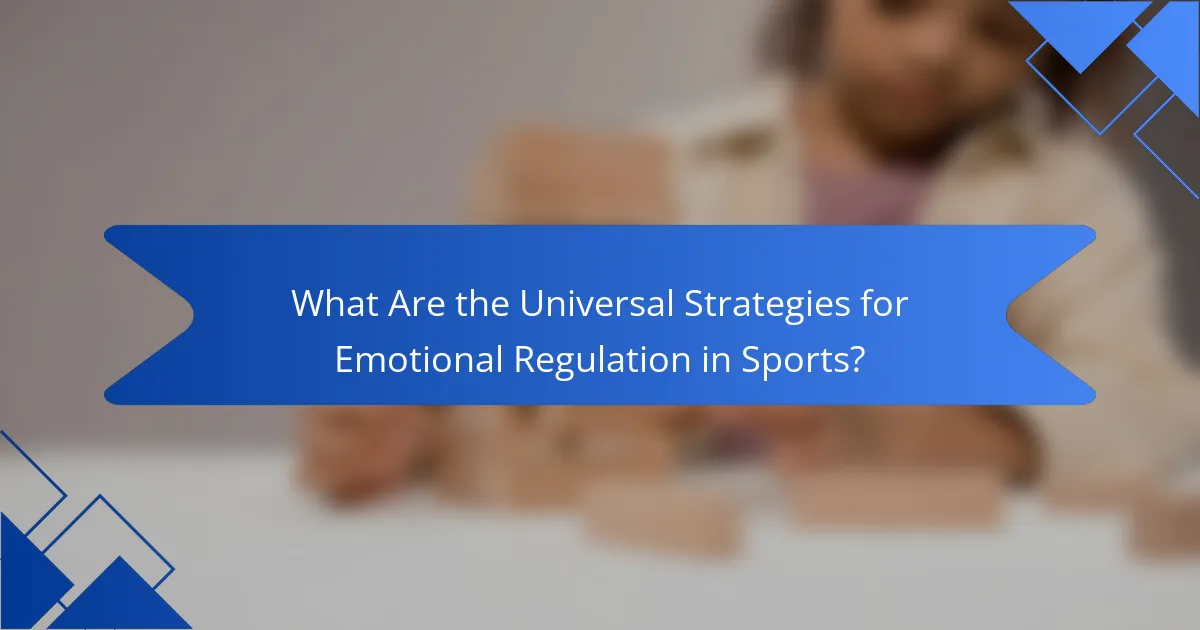
What Are the Universal Strategies for Emotional Regulation in Sports?
To master emotional regulation in sports, athletes should adopt strategies like cognitive restructuring, mindfulness practices, and goal setting. These approaches help transform negative thoughts into positive ones, enhancing performance. Cognitive restructuring involves identifying and challenging irrational beliefs, while mindfulness focuses on present-moment awareness, reducing anxiety. Goal setting provides a roadmap, fostering motivation and focus.
Which Techniques Are Commonly Used by Professional Athletes?
Professional athletes commonly use techniques like visualization, mindfulness, and cognitive restructuring to enhance emotional regulation. These methods help athletes manage stress, improve focus, and maintain motivation. Visualization involves mentally rehearsing performances to build confidence. Mindfulness practices increase awareness of thoughts and emotions, allowing for better control during competition. Cognitive restructuring helps athletes challenge negative thoughts and replace them with positive affirmations, fostering a resilient mindset.
How Can Breathing Exercises Help in High-Pressure Situations?
Breathing exercises can significantly enhance performance in high-pressure situations by promoting emotional regulation. These techniques help athletes manage stress, maintain focus, and improve decision-making under pressure. Controlled breathing activates the parasympathetic nervous system, reducing anxiety and fostering a calm mindset. This unique attribute allows athletes to respond rather than react, enhancing their overall performance. As a result, athletes who incorporate breathing exercises into their training experience greater resilience and success in competitive environments.
What Role Does Visualization Play in Emotional Regulation?
Visualization plays a crucial role in emotional regulation by enhancing focus and reducing anxiety. This technique enables athletes to mentally rehearse successful performances, leading to improved confidence and emotional stability. Research indicates that visualization can lower stress levels, fostering a positive mindset essential for athletic success. By creating vivid mental images, athletes can better manage emotions, ultimately enhancing their performance under pressure.
How Can Mindfulness Practices Be Integrated into Training?
Mindfulness practices can be integrated into training by incorporating techniques that enhance emotional regulation. Start with focused breathing exercises before workouts to center attention and reduce anxiety. Use visualization techniques during training to mentally rehearse performance scenarios, fostering a positive mindset. Implement short mindfulness breaks throughout training sessions to encourage reflection and self-awareness. Finally, integrate mindfulness into cooldown routines, promoting recovery and emotional balance post-training.
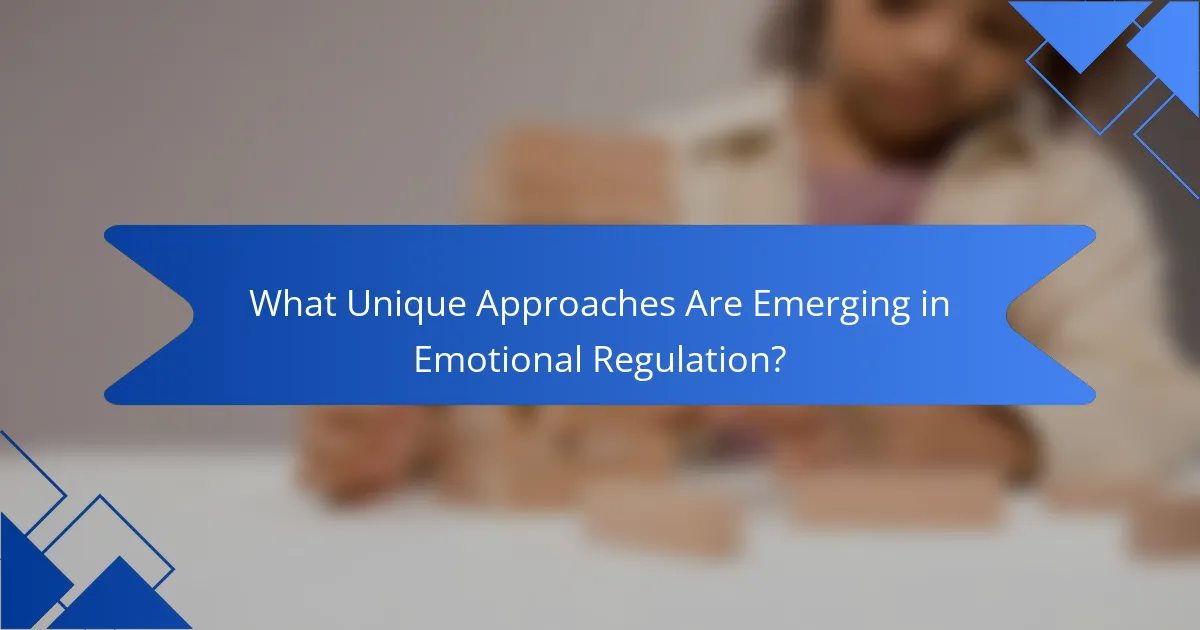
What Unique Approaches Are Emerging in Emotional Regulation?
Emerging approaches in emotional regulation focus on cognitive restructuring, mindfulness, and biofeedback. Cognitive restructuring helps athletes reframe negative thoughts, enhancing focus and performance. Mindfulness practices cultivate present-moment awareness, reducing anxiety during competitions. Biofeedback utilizes technology to monitor physiological responses, allowing athletes to gain control over their emotional states. These methods collectively promote resilience and optimal performance in sports.
How Are Sports Psychologists Innovating Emotional Regulation Techniques?
Sports psychologists are innovating emotional regulation techniques by integrating mindfulness practices and cognitive-behavioral strategies. These methods enable athletes to manage stress and anxiety effectively, enhancing performance. For example, visualization techniques help athletes mentally rehearse scenarios, improving focus and confidence. Additionally, biofeedback tools allow athletes to monitor physiological responses, promoting self-regulation. Research indicates that athletes employing these innovative techniques experience improved emotional resilience and overall well-being, critical for athletic success.
What Role Does Technology Play in Monitoring Emotional States?
Technology plays a crucial role in monitoring emotional states by providing real-time data and feedback. Wearable devices and apps track physiological indicators like heart rate and skin conductance, correlating them with emotional responses. These tools enable athletes to recognize stress and anxiety levels, facilitating timely interventions. For example, biofeedback systems offer insights that help in emotional regulation, enhancing performance. Data analytics further personalize training programs, aligning emotional well-being with athletic success.

What Rare Emotional Regulation Techniques Can Athletes Explore?
Athletes can explore rare emotional regulation techniques such as visualization, mindfulness meditation, and breath control. These methods enhance mental resilience and focus, crucial for peak performance. Visualization allows athletes to mentally rehearse success, improving confidence. Mindfulness meditation fosters present-moment awareness, reducing anxiety. Breath control techniques help manage physiological responses to stress, promoting calmness. Incorporating these techniques can lead to significant improvements in emotional regulation and overall athletic success.
What Are the Benefits of Biofeedback in Sports?
Biofeedback enhances emotional regulation, leading to improved athletic performance. It allows athletes to gain awareness of physiological functions, enabling better control over stress responses and mental states. This technique fosters resilience, helping athletes maintain focus during competition. Research shows that biofeedback can significantly reduce anxiety levels, enhance concentration, and improve overall mental well-being, contributing to athletic success.
How Can Neurofeedback Training Enhance Emotional Control?
Neurofeedback training enhances emotional control by promoting self-regulation of brain activity. This training helps athletes develop mental resilience, leading to improved performance. Studies show that neurofeedback can reduce anxiety and increase focus, essential for peak athletic performance. By training specific brainwave patterns, individuals can learn to manage their emotional responses effectively, enhancing overall emotional regulation.
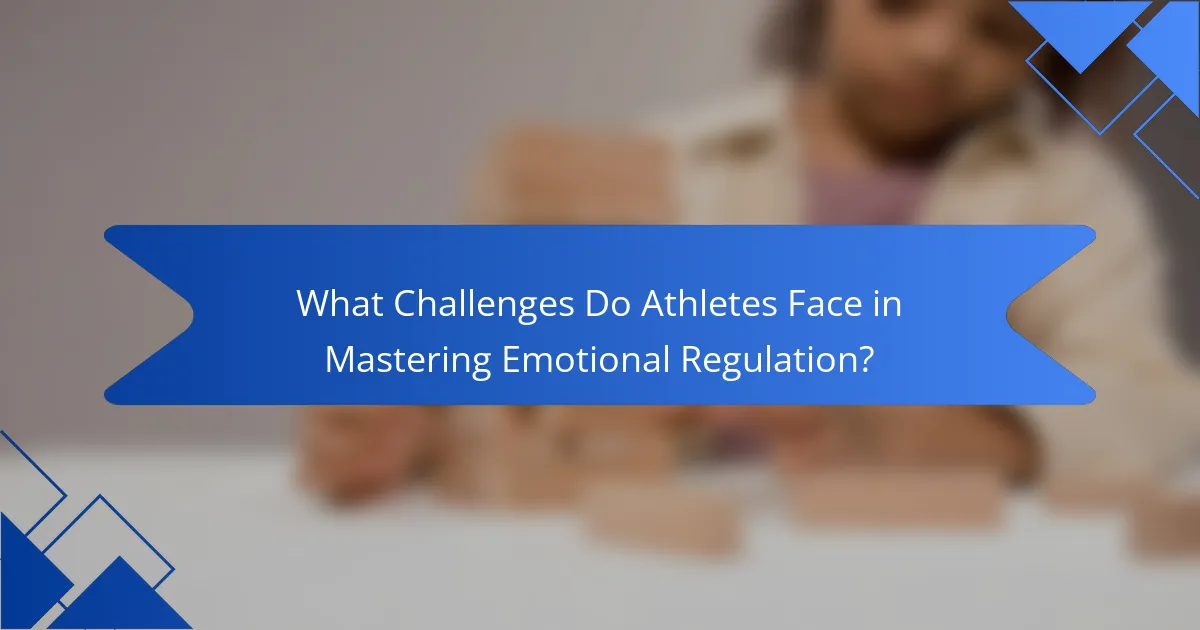
What Challenges Do Athletes Face in Mastering Emotional Regulation?
Athletes face various challenges in mastering emotional regulation, including performance anxiety, negative self-talk, and emotional fatigue. These obstacles can hinder focus and motivation. Performance anxiety often leads to heightened stress, impacting overall performance. Negative self-talk diminishes confidence, creating a cycle of self-doubt. Emotional fatigue, stemming from intense training and competition, can reduce resilience. Addressing these challenges requires tailored strategies, such as mindfulness practices, cognitive restructuring, and emotional awareness training. These methods enhance emotional regulation, contributing to athletic success.
How Do Performance Pressures Affect Emotional Stability?
Performance pressures can significantly undermine emotional stability by inducing stress and anxiety. Athletes often experience heightened expectations, leading to negative thought patterns. Mastering emotional regulation techniques can mitigate these effects, fostering resilience and enhancing performance. Strategies include cognitive reframing, mindfulness practices, and positive self-talk, which help athletes maintain focus and composure under pressure. By changing thoughts, individuals can transform their emotional responses, ultimately contributing to athletic success.
What Common Misconceptions Exist About Emotional Regulation?
Many misconceptions surround emotional regulation, particularly in athletic contexts. One common belief is that emotional regulation means suppressing feelings, which can hinder performance. Instead, it involves recognizing and managing emotions effectively. Another misconception is that emotional regulation is solely innate; in reality, it can be developed through practice and strategies. Athletes may also think that emotional regulation is unnecessary; however, it is crucial for maintaining focus and resilience during competition. Lastly, some believe that emotional regulation is only relevant during stressful situations, but it is beneficial for overall mental well-being and performance enhancement.
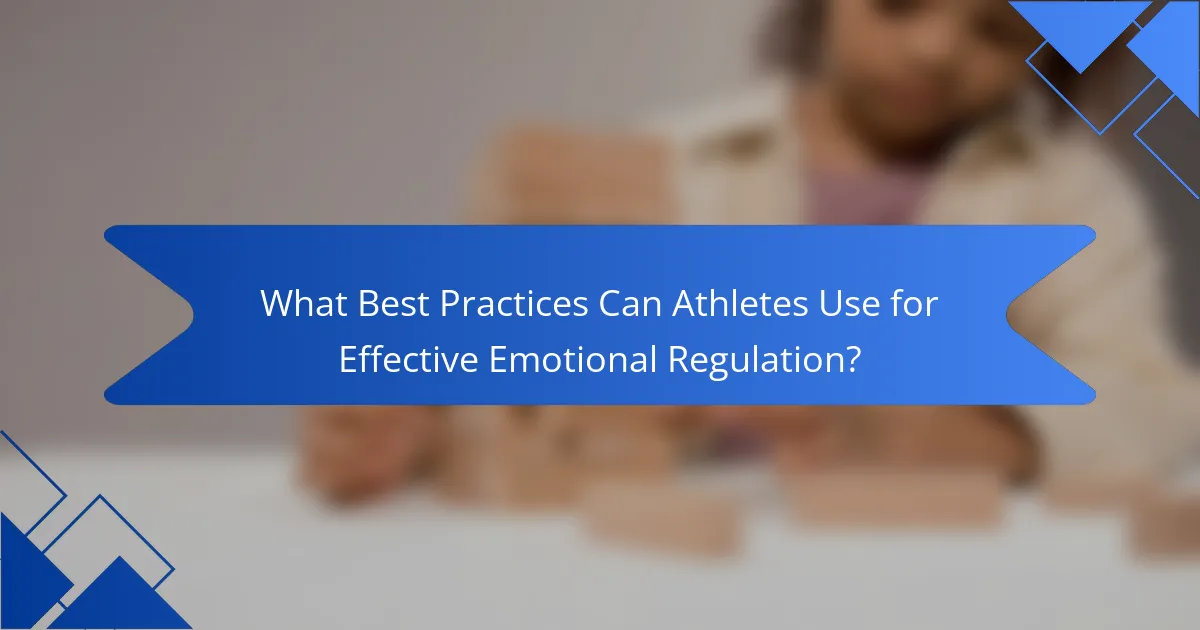
What Best Practices Can Athletes Use for Effective Emotional Regulation?
Athletes can enhance emotional regulation through cognitive restructuring, mindfulness techniques, and goal setting. Cognitive restructuring helps athletes reframe negative thoughts into positive ones, fostering resilience. Mindfulness techniques, such as meditation and breathing exercises, promote present-moment awareness, reducing anxiety. Goal setting provides clear objectives, motivating athletes and enhancing focus. Implementing these practices leads to improved performance and mental well-being.
How Can Athletes Develop a Personalized Emotional Regulation Plan?
To develop a personalized emotional regulation plan, athletes should identify triggers, establish coping strategies, and practice mindfulness techniques. Begin by recognizing specific emotional responses during performance. Next, create a toolkit of strategies such as breathing exercises or positive self-talk. Regular practice of mindfulness can enhance awareness and control over emotions, leading to improved athletic performance.
What Common Mistakes Should Athletes Avoid in Emotional Regulation?
Athletes should avoid negative self-talk, overgeneralizing, and ignoring emotions. These mistakes hinder emotional regulation and performance. Negative self-talk creates a defeatist mindset, while overgeneralizing can lead to a lack of confidence. Ignoring emotions prevents athletes from addressing underlying issues. Recognizing and reframing thoughts fosters resilience and enhances focus during competition.
How Can Coaches Support Emotional Regulation in Their Athletes?
Coaches can support emotional regulation in athletes by fostering a positive environment and teaching coping strategies. They should encourage open communication, helping athletes express their feelings. Implementing mindfulness techniques can enhance self-awareness, allowing athletes to recognize emotional triggers. Regular feedback and goal-setting can build resilience and focus. Engaging in team-building activities strengthens relationships and promotes a supportive culture, which is essential for emotional stability.
What Strategies Can Be Implemented for Immediate Emotional Control?
To achieve immediate emotional control, athletes can implement cognitive restructuring techniques. These include reframing negative thoughts, practicing mindfulness, and utilizing visualization strategies. Cognitive restructuring helps in identifying and altering unhelpful thinking patterns, leading to improved emotional responses. Mindfulness enhances awareness of emotions, while visualization prepares athletes mentally for performance, reducing anxiety and enhancing focus.
